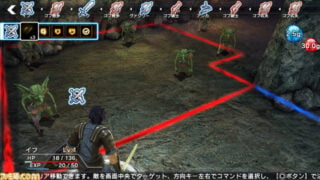
The latest issues of Famitsu and Dengeki this week have the scoop on Kadokawa Games‘ upcoming PlayStation simulation RPG Natural Doctrine.
Sokuho@Hokanko has come through with a detailed description of this week’s Famitsu preview, which we’ve translated below. For a few more details, see our report from this week’s Dengeki here.
Outline
- Platforms: PlayStation 4, PS3, and PS Vita
- Release Date: February 22
- Price: Pending
- Executive Producer: Yoshimi Yasuda
- Producer: Kensuke Tanaka
- Character Design Cooperation: Ufotable
- Character Design: Atsushi Ikariya (Ufotable)
- Game Building Director: Atsushi Ii (Black Bandit Q)
- Music: Noriyuki Asakura
A world in chaos by the erosion of subspecies and other species, the humans opposed them with swords and magic and built the fortress city Feste as the center of their livelihoods. Clearing the goblin’s dens will grant access to resources essential for humanity. It is for this that main character Jeff sets out on a mission as a guard soldier.
Characters
- Jeff – A young man and the protagonist. He uses one-handed and two-handed swords in close combat and is also accustomed to handling guns. He aims to join the elite fortress city soldier troupe, but because of his family’s social standing and personal connections, he is still waiting for that opportunity.
- Vasilisa – The first female character shown. Even though she is young, she is a guard soldier with excellent battle sense. She has an older sister who is one of the 100 commanding officers of the soldier troupe. She trains day and night to reach that same goal. As an accomplice, she gets along and banters with Jeff.
- Anca – The girl character with the long blonde ponytail. She is a leader of the tunnel path-finding brigade. She excels at generalship and the use of medical supplies, and fights for herself with a gun in hand. Her dream is to get citizenship in the fortress city and implement a medical system that is supportive of everyone, even the weak.
World View
- In the outskirts of Feste, subspecies like minotaurs, goblins, and orcs have setup bases. They plan on invading from those locations.
- With simulation RPGs things are limited within the grid, but that scope is wide, it’s important how everything is arranged within the grid limits. There are also merits for things like not receiving shooting damage depending on the place, etc.
- There is also a link attack you can do when you line up units.
- In multiplayer mode you can also play as races other than human.
Interview
Tidbits from Yoshimi Yasuda and Kensuke Tanaka.
- Yasuda: Kadokawa Games has reached their fifth anniversary, but its necessary to think about substrate stability and mid-range growth, so with that in mind we are working on a game that represents our flagship. In order to continue growing, we’re making a team with skill and knowledge. I hit it off with Tanaka, I had heard he had wanted to make a simulation RPG. I wanted to challenge the possibilities with simulation RPGs so we started with the first phase of titles for Kadokawa Game Studio.
- Tanaka: We were thinking that we wanted to challenge a new standard, like Fire Emblem and Tactics Ogre had.
- Yasuda: There is a strong demand for it in both Japan and overseas markets. Tanaka was a well qualified person among us, when we started planning we decided to discuss everything together. The only parts I wanted to do were regarding game design and mechanics.
- Tanaka: At first I planned on being a devoted to a producer, but after not reaching a unified opinion about scenarios I ended up making them myself.
- As for the story setting, we built a cultural sphere where mankind is kept in balance to some degree with subspecies. The humans invade the goblin’s home, but when they see the goblins and the other species, what will happen? I want each action in the title to be inlaid with strategic doctrine.
- The story is drawn from the human side the entire time, but when you progress the story, it develops where you can imagine what the subspecies are expecting.
- Tanaka: I wondered if it was possible for a game where various ways of thinking are considered. The title reflects this theme as well, confronting the “doctrine” of “nature”.
- You can stack human sized units on large grid spots, and since you can arrange them where you want within the grid spot it’s important to pay attention to the arrangement.
- If there is a tree or wall in a grid spot it can be an obstacle, which can obstruct a connection in the link system. Units have jobs, construct their skill trees as they grow.
- Yasuda: In simulation RPGs up until now you basically have soldiers in the front, but in this title you can decide your ally’s positions, confusing your enemy.
Development Status
80 percent complete.
